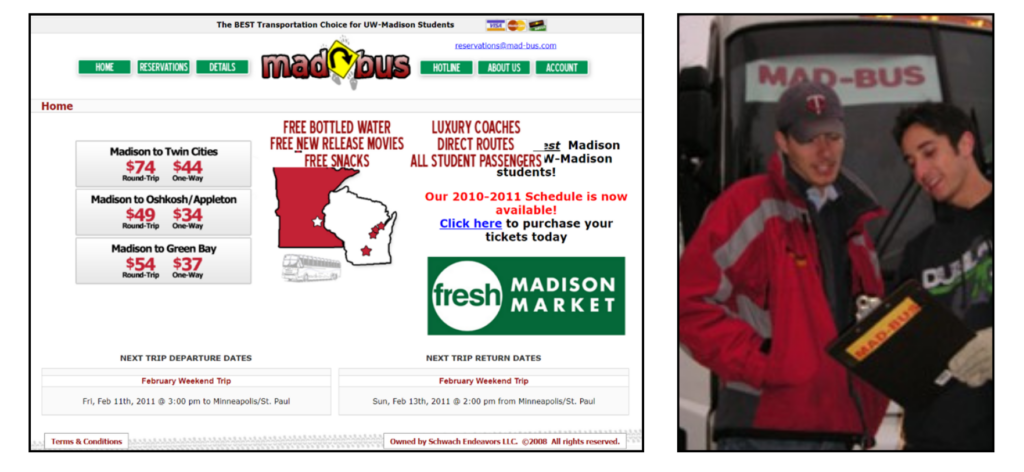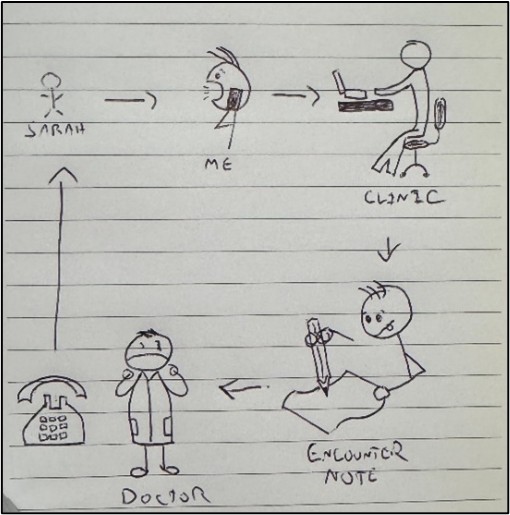I was an 18-year-old at University of Wisconsin – Madison when I started my first company. Mad-bus provided tailored transportation to UW-Madison students from Minnesota – we picked students up at their dorms, showed the latest VHS releases (and fixed the VCR when it jammed), and inked partnerships with Red Bull (oof!), Fresh Market, and, for a hot second, another student startup called Madtown Munchies (shout out to my buddy @Jeremy Neren). Over my four years at college, I became known in certain circles as the “bus boy” (rarely a compliment, thanks @jared berman).

I was a mediocre student (I scraped by with Bs and Cs), but I couldn’t get enough of running the business. I had no idea what I was doing, but at our peak we were routing 11 buses to four campus pick-up locations and bussing over 700 students per school break.
While I had student workers, as a small business owner, I did every job in the business. I was our webmaster, SEO optimizer, supplier contract negotiator, and our logistics analyst (I printed out mapquest directions).
The business ran for 10 years, I put myself through college, and I learned two time-honored lessons:
1. “For the things we have to learn before we can do them, we learn by doing them.” – Aristotle
I learned a little from reading, and a lot from doing. Simple turned out to better from a messaging standpoint. Flyers with those “hanging chads” were far more effective than any digital channel (this is before UW got Facebook). I had to learn the difference between the gateway and the payment processor to take online payments (this is before stripe), and I learned why Amex has such good perks… they charge businesses a lot (no thanks).
2. “If the power to do hard work is not a skill, it’s the best possible substitute for it.” – James Garfield
As a full-time student whose exam schedule coincided with my small business “go-lives,” I learned to work hard at both (it probably helped that I didn’t get invited to that many parties.) Every year the business grew, I pushed harder to keep up. I was a mediocre student from Minnesota, running a company in a space I knew nothing about. As an impressionable 18-year-old, I learned an incredible lesson that Angela Duckworth articulates in Grit: “As much as talent counts, effort counts twice.”

Twenty-three years later, Hummingbird, my third business, has 300+ people and is growing rapidly. We partner with providers to make scheduling, triage, medication refills, and other patient access experiences better. Part of how we do this is to take on the call center.
Both my life experience and my loving wife tell me that I don’t know nearly as much as I think: There was no way I was going to understand the call center without working in the call center.
So, in between jumping on sales calls, creating board materials, fundraising, interviewing, and generally doing the day-to-day grind of building a company, I trained as a call center agent and now take patient calls for a large academic medical center.
What have I learned? First, being a call center agent is damn hard.
There are endless nuances: each specialty has their own way of doing things, the enterprise systems we use can be unintuitive, and sometimes the human on the other end of the phone is having a bad day…like, a really bad day. One of the ways we fix access is by creating good jobs for the folks on the front line (which we talk a lot about around here).
What else did I learn? Well, often the job just doesn’t really make sense.
Like, why did I have to put a patient on hold just to call a clinic to wait on hold, just so the clinic could leave a message for the doctor to then just call the patient back? See Figure A for my highly professional process diagram.

It’s one thing to know the systemic issues behind healthcare access, but it’s a different thing to have a primary care physician call you to help one of her elderly patients’ re-fax a neurology referral because we didn’t receive the fax the first time. (Spoiler: We did receive the fax. It was just backlogged in a fax black hole at the clinic, which is frighteningly normal across the country.)

It’s perhaps obvious that we can leverage technology to make self-service better – see Figure B (I’d love to just text most of my needs). It’s a lot less obvious, however, that the mountain of faxes piling up in brick-and-mortar clinics is getting in the way of implementing texting. We now know we have to fix our referral problem at the clinic.
We also know that we need to learn by doing and that working hard to fix something is a skill unto itself… and, man, does the Hummingbird team apply the elbow grease. This job is hard, and together we’re changing the face of healthcare access.